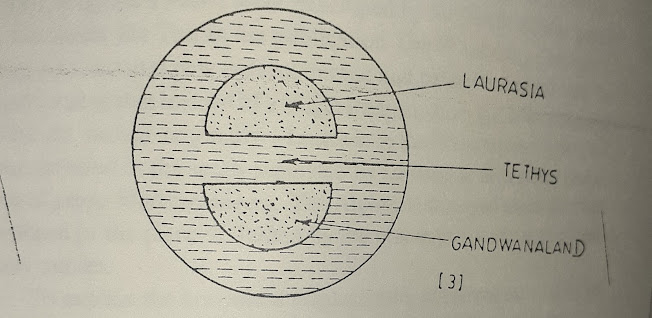Continental drift refers to the horizontal movement of the continents on the vast scale.
The idea of moving continents is not new and many scholars had introduced their own hypothesis regarding this.
In 1910 and 1912 respectively, a German meteorologist Alfred Wegener, suggested that the continents had drifted apart and proposed the hypothesis regarding the actual cause for the movement of the continents.
Wegener suggested that continents are large thin cakes of sial (upper portion of the crust) floating above the viscous sima (lower portion of the crust below sial).
According to him, the rift of the continent is the movement of upper blocks of sial with correspondence of viscous sima.
Apart from this, Wegener suggested that at the end of the
Carboniferous period of Paleozoic era, the present day continents were never
separated then and was one giant supercontinent named as Pangea and surrounded by
world-ocean called Panthalassa.
According to the hypothesis, all the continental mass was concentrated in the large continental mass Pangea and was intact till the end of the Carboniferous period.
During the late Paleozoic period, the so called supercontinent broke into pieces and separated from each other.
Now the separated mass gradually began to move away from each other.
He suggests that, southern part of the Pangea broke apart during Mesozoic and the northern part broke apart in Tertiary period.
The breakdown of the continent is supposed to be influenced by the tidal force and also due to the rotation of the earth.
The drifted upper (northern hemisphere) from a supercontinent is called Laurasia and the southern portion is named as Gondwanaland.
Wegner also proposed that the continents while drifted through the oceanic crust gave rise t the mountain ranges on the respective edges. And the landmass breaking off during the drift produced small landmass on the oceanic crust like islands.
Some of the evidences are:
1) The first evidence suggests the occurrence of plant fossil called Glossopteris of the late Paleozoic age in the sedimentary rocks of South America, India, Africa, and Australia. The same plant fossil was uniformly distributed in these continents suggests that these continents are drifted from the single supercontinent.
2) Wegner collected paleoclimatic evidence from the sedimentary rocks of each geological period and found that many ancient climatic belts were in different position from the present belts. This shows that the change in the climatic belts and the shift of the belts through geological time is supposed to be polar wandering. It suggests that the apparent movement of earth's geological poles. This change in the polarity of the continent suggests two alternatives. First suggest that the poles had actually moved from the stationery continents and second suggests that poles had remained immobile unlike the moving continents.
3) The widespread glaciations towards the Paleozoic era found on the continents of southern hemisphere support the idea of continental drift unlike he continents of northern hemisphere as they are supposed to be drifted in different geological time.
4) The similarity of the Pre Cambrian rock sequence of Africa, India, Brazil and Australia supports this hypothesis of continental drift. Apart from the rock sequence the idea is also supported by the occurrence of the same fossil in distributed sequences.
Objection to Wegner's hypothesis:
1) He suggested that the drifted land mass perfectly fits in the initial supercontinent but the fit suggested is hardly perfect. This cannot be expected to be real due to others physical stress and deformation during the drift.
2) So called plant fossils could have been transported through different continents by the means of different mediums and the occurrence of same fossil cannot signify that the continents were once joined together.
3) Most of the researchers suggest that it is mechanically impossible for such large scale drifting.
4) Polar wandering might be the cause due to the movement of the pole not the entire continents.




Comments
Post a Comment